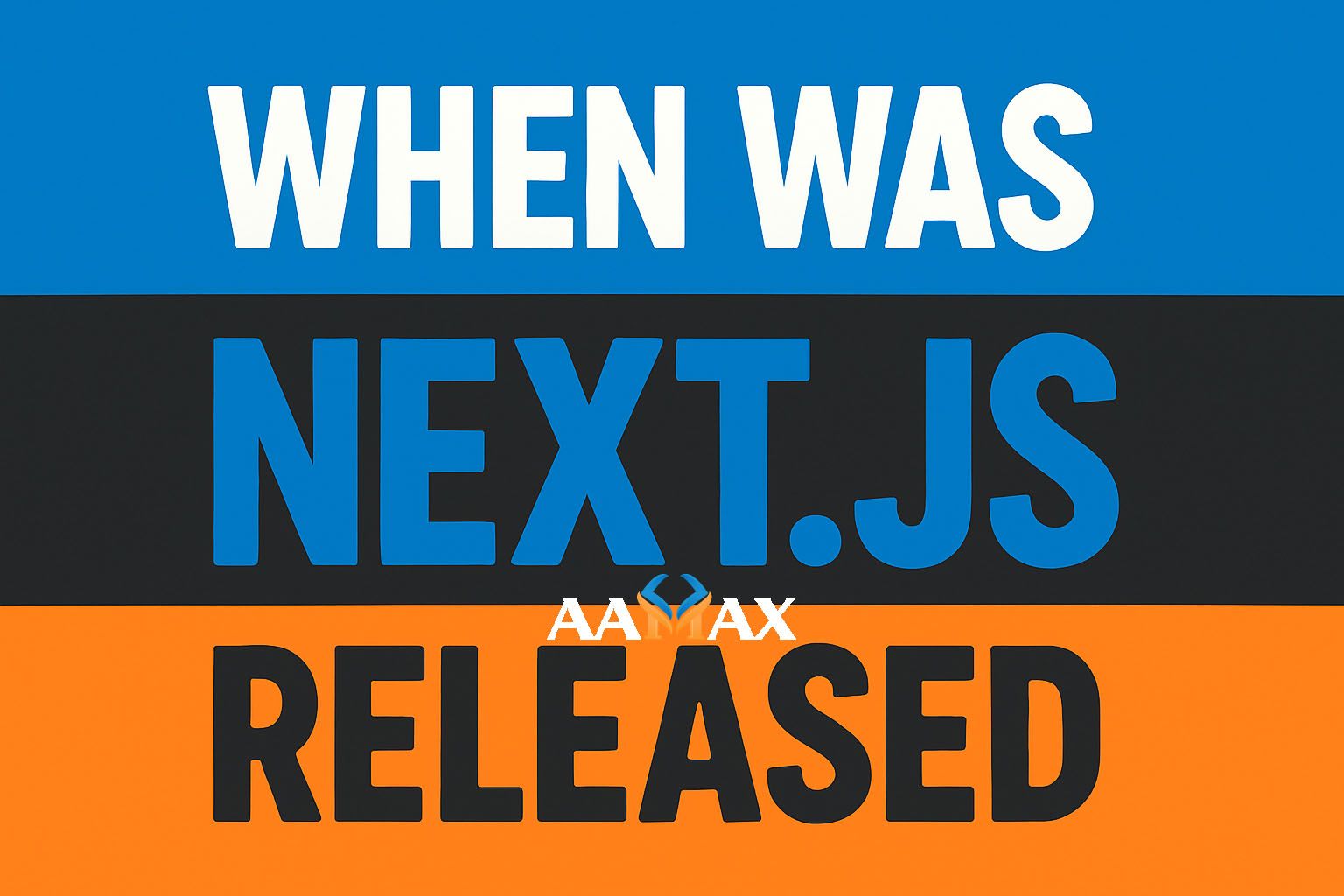
When Was Next JS Released
Next.js has become one of the most influential frameworks in the modern JavaScript ecosystem. Whether you are a developer, business owner, or tech strategist, you've likely heard of its power in creating fast, scalable, and SEO-friendly applications. But before exploring what Next.js can do today, it's important to understand where it started. So, when was Next.js released, and how did it evolve into the powerhouse framework it is now?
This in-depth guide explores the complete timeline of Next.js---from its initial launch to its groundbreaking advancements. We examine how the JavaScript landscape looked when Next.js emerged, why it was created, how it transformed modern development, and how businesses today can leverage it. If you are considering using Next.js within the MERN ecosystem, partnering with experts like AAMAX can help you unlock its full potential. AAMAX is a full-service digital marketing and development company offering MERN Stack Development, Web Development, Digital Marketing, and SEO services.
What Is Next.js?
Next.js is a React framework created to simplify building production-ready web applications. It adds essential capabilities on top of React, including:
- Server-Side Rendering (SSR)
- Static Site Generation (SSG)
- Incremental Static Regeneration (ISR)
- File-system based routing
- API routes
- Image optimization
- Edge rendering
- Middleware support
- Bundling and compiling optimizations
Before Next.js existed, React developers had to assemble these capabilities manually. Next.js introduced a powerful, standardized way of doing this---paving the way for the modern full-stack JavaScript era.
The Release of Next.js --- When Did It Happen?
Next.js was officially released on October 25, 2016 by a company then called ZEIT, known today as Vercel. The framework launched as an open-source project, immediately gaining traction due to its simplicity and practical utility.
### Why Was 2016 an Important Year?
To understand the significance of the release date, it's important to look at the state of JavaScript development in 2016:
- React was widely adopted but lacked built-in features for production.
- Developers relied on client-side rendering, which had poor SEO performance.
- Configuring Webpack and Babel was time-consuming.
- Routing and server rendering required manual setup.
Next.js arrived not just as a framework---but as a solution to these growing challenges.
The Vision Behind Next.js
The creators of Next.js aimed to solve a core problem: React was powerful but not complete. It was purely a UI library that lacked structure for building full production applications.
The vision was clear:
- Make SSR easy
- Reduce configuration complexity
- Provide performance out of the box
- Enable hybrid rendering strategies
- Allow developers to focus on building features rather than tooling
This vision guided the early versions of Next.js and still shapes its evolution today.
A Timeline of Major Next.js Releases and Milestones
To fully appreciate how far Next.js has come since 2016, here's a detailed timeline of its major releases and what each contributed to its popularity.
Next.js 1.0 (2016) -- The Beginning
The first version introduced: - Universal (isomorphic) JavaScript apps - Automatic server-side rendering - Basic routing - Zero-config setup
This was groundbreaking at the time. Developers could finally build SSR apps without fighting build tools.
Next.js 2.0 (2017) -- Performance Enhancements
This update focused on stronger developer experience: - Faster builds - Improved error handling - Better hot reloading
It refined the architecture to improve reliability.
Next.js 3.0 (2017) -- Dynamic Import and Code Splitting
A major milestone introduced: - import() for dynamic component
loading - Automatic code splitting
This dramatically improved performance for large applications.
Next.js 4.0 (2017) -- Universal Webpack Support
This version supported: - Webpack 3 improvements - Faster builds - Better minification
Next.js was now becoming suitable for enterprise-grade applications.
Next.js 5.0 (2018) -- Plugins, Custom Routing & More
Introduced: - Next.js plugins - Better routing options - Multi-zone support
This gave developers more flexibility and power.
Next.js 6.0 (2018) -- New App Directory Structure
Notable features: - Updated page system - Improved rendering controls - Optimized static export behavior
Next.js was becoming more user-friendly.
Next.js 7.0 (2018) -- Preloading and Suspense
This introduced: - Automatic prefetching - Support for React Suspense - Improved bundling
This made navigation faster than ever.
Next.js 8.0 (2019) -- Serverless Functions
One of the most important updates: - Built-in serverless API routes - Incremental builds - Better SSR caching
Developers could now build full-stack apps inside Next.js itself.
Next.js 9.0 (2019) -- Static Site Generation
A huge leap forward: - SSG with getStaticProps - Dynamic routing - API
routes matured - Automatic TypeScript support
Now Next.js could build fast, scalable static sites---competing with Gatsby.
Next.js 10.0 (2020) -- Image Optimization Component
This update introduced: - Next.js <Image> component -
Internationalized routing - Improved analytics and monitoring - Faster
SSG performance
It established Next.js as the leader in image performance optimization.
Next.js 11.0 (2021) -- Webpack 5 and Conformance
Key improvements: - Built-in ESLint integration - Webpack 5 support - Better error overlays - Faster refresh speeds
Next.js became more consistent and reliable.
Next.js 12.0 (2021) -- Rust Compiler (SWC)
This release added: - SWC-based tooling for faster build times - Middleware - Edge functions support
Rust-based compilation significantly boosted developer productivity.
Next.js 13.0 (2022) -- App Router Revolution
The most disruptive update yet introduced: - App Router - Server Components - Layouts and nested routing - Streaming and Suspense improvements - Turbopack support (experimental)
This shifted Next.js into a new era of React architecture.
Next.js 14.0 (2023) -- Stability and Enterprise Features
This version focused on: - Stable app router features - Partial rendering - Better performance on the edge - Advanced caching strategies
Next.js was now fully optimized for enterprise and large-scale platforms.
The Impact of the 2016 Release on Modern Web Development
The release of Next.js in 2016 changed the future of React development forever. Here's why:
### 1. It Made SSR Accessible
Before Next.js, SSR required: - Custom Express servers - Webpack configuration - Babel setup - Caching and hydration logic
Next.js packaged all of this automatically.
### 2. It Improved SEO for React Apps
React alone struggled with SEO. Next.js solved this with: - Pre-rendering - Fast server responses - Crawlable HTML
This made React viable for SEO-intensive websites.
### 3. It Merged Frontend and Backend Development
With API routes and server components, Next.js blurred the line between frontend and backend engineering---making full-stack JavaScript more accessible.
### 4. It Enabled Hybrid Rendering Models
Next.js lets developers choose: - SSR - SSG - ISR - Edge rendering - CSR
This flexibility didn't exist before.
### 5. It Fueled the Rise of Jamstack and Modern Web Apps
Many modern development patterns---including Jamstack---were accelerated or enabled by Next.js features.
Why the Release Date Matters for Businesses Today
Understanding when Next.js was released helps businesses see how long the framework has been tested, refined, and improved. With nearly a decade of evolution, it is now:
- Stable
- Enterprise-ready
- Performance-optimized
- Backed by a major company (Vercel)
- Used by global brands
This maturity makes Next.js a safe and strategic choice for serious projects.
Should You Use Next.js in Your Project?
The answer depends on your goals. Consider Next.js if you need:
- Excellent SEO
- Lightning-fast performance
- Scalable architecture
- Hybrid rendering
- Smooth user experience
- Easy integration with MERN stack
- Built-in API capabilities
- High security and modern development practices
If your business wants to build a modern, high-performance application, Next.js offers everything needed for success.
The Role of Next.js in a MERN Stack Project
Next.js enhances the traditional MERN stack by replacing React with a more advanced framework. While React is still at its core, Next.js adds capabilities that make MERN apps:
- More SEO-friendly\
- Faster\
- Easier to scale\
- Better optimized\
- More secure\
- Full-stack capable
This is why many companies now prefer MERN + Next.js for production-grade web platforms.
Hire AAMAX for MERN + Next.js Development
Building a high-performance application requires expertise. AAMAX provides professional MERN Stack Development services with real-world experience in:
- Next.js development
- Full-stack JavaScript applications
- Search engine optimized platforms
- Responsive and scalable web systems
- Digital marketing and SEO optimization
Whether you want to migrate to Next.js or build a modern application from scratch, AAMAX can help.
Conclusion
Next.js was released on October 25, 2016, marking the beginning of a new era in web development. Over the years, it has transformed from a simple SSR framework into one of the most powerful tools for building modern applications. Its evolution showcases how much innovation can happen within a relatively short period.
Today, Next.js remains a top choice for developers and businesses seeking high performance, flexibility, and scalability. If you're considering using Next.js in your next project, understanding its origins and capabilities will help you make an informed decision---and partnering with experts ensures that you get the most out of the technology.







